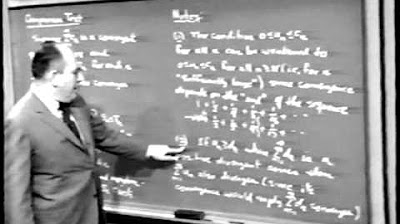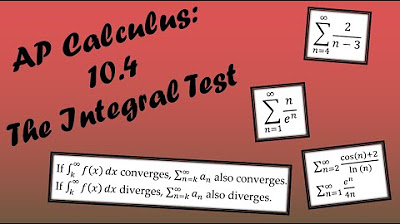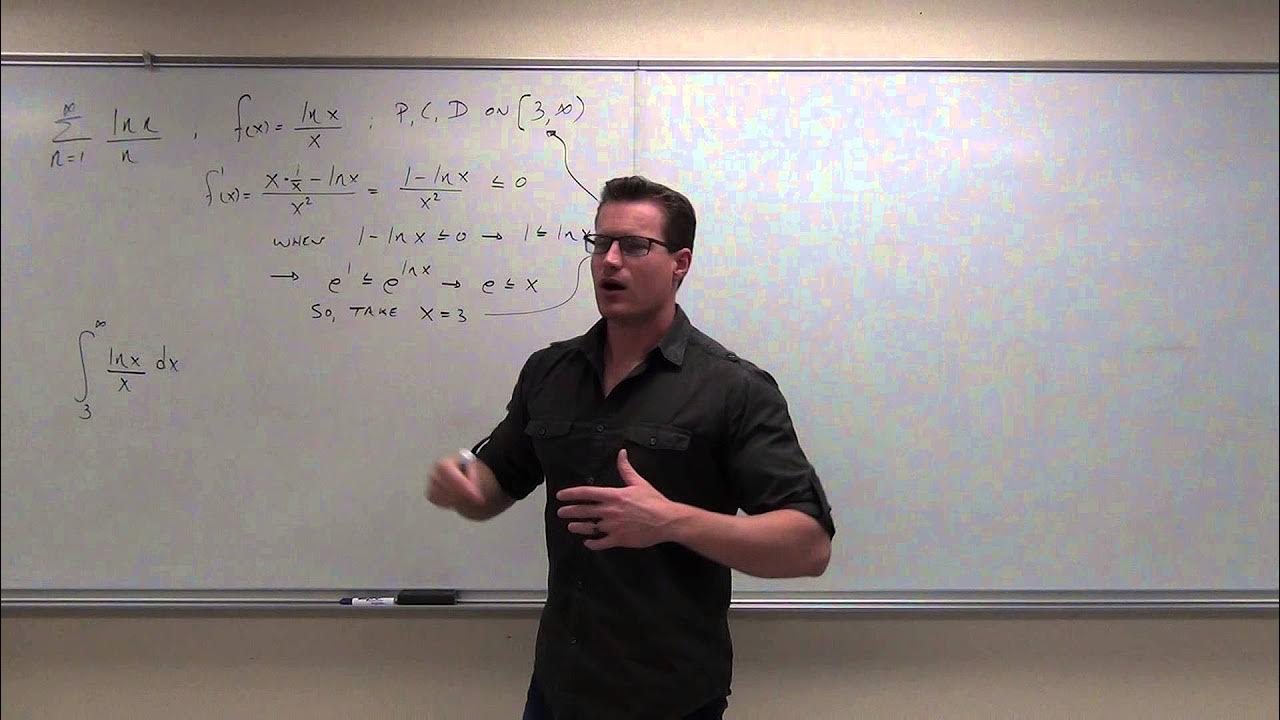Calculus Chapter 5 Lecture 51 Convergence Tests 1
TLDRIn this calculus lecture, Professor Greist introduces various convergence tests to determine if an infinite series converges or diverges. The integral test is discussed, requiring a positive, decreasing sequence and a related continuous function. The comparison test is also covered, comparing two sequences to infer convergence. The lecture emphasizes the importance of identifying leading terms for asymptotic analysis and the limit test, which assesses the convergence of series based on the ratio of their leading terms. The goal is to discern convergence and divergence with practice, highlighting the usefulness and applicability of these tests in mathematical analysis.
Takeaways
- 📚 The lecture introduces various convergence tests for infinite series, emphasizing the need for practice to discern convergence and divergence effectively.
- 📉 The Integral Test is presented with its conditions, such as the sequence being positive and decreasing, and the comparison of the series to the integral of the continuous function.
- 🔢 The Integral Test is not universally applicable due to its strict conditions and the complexity of improper integrals, but it is useful in specific examples like the harmonic series.
- 📈 The p-Series is highlighted as a fundamental example where the Integral Test is applied to determine convergence when p > 1 and divergence when p ≤ 1.
- ⚖️ The Comparison Test is explained with its simple hypotheses, comparing two sequences where if one series converges, the smaller series must also converge.
- 🔄 The Comparison Test's effectiveness is demonstrated through examples, but it also points out the potential confusion in identifying the correct sequences for comparison.
- 📉 An example of using the Comparison Test with a series involving powers and roots is provided, illustrating the process of bounding terms to determine convergence.
- 📚 The Limit Test is introduced as a powerful and easy-to-apply method for determining the convergence of series by comparing the leading order terms of the sequences.
- 🔍 The importance of asymptotic analysis in the Limit Test is underscored, as it helps in identifying the leading order term to predict the series' behavior.
- 📈 The script provides examples of series with complex terms, showing how to compute the leading order term to apply the Limit Test and determine convergence or divergence.
- 🔑 The overarching theme of the lecture is the strategy of comparison in convergence tests, which ultimately relies on finding the asymptotics or leading order terms of the series.
Q & A
What is the main topic of Professor Greist's lecture 51?
-The main topic of the lecture is convergence tests for determining when an infinite series converges or diverges.
What is the strategy employed to determine the convergence or divergence of a series based on a sequence a sub n?
-The strategy of comparison is employed, where the series is compared with another sequence B sub n or a continuous function related to the original sequence.
What are the conditions for the Integral Test to be applicable?
-The sequence a sub n must be positive and decreasing, and it must be possible to connect the dots to form a continuous function a of X that is also positive, decreasing, and agrees with the sequence at every integer point.
Why is the Integral Test not considered to be the simplest or most universally applicable test?
-The Integral Test has strict hypotheses and can be difficult to use due to the complexity of improper integrals, limiting its overall usefulness.
What is a key example where the Integral Test works well?
-The Integral Test works well in determining that the harmonic series diverges by comparing it to the continuous integrand 1 over X.
What is a P-series and how does its convergence or divergence relate to the value of P?
-A P-series is a series of the form sum from 1 to infinity of 1 over N to the P. It converges when P is strictly greater than 1 and diverges when P is less than or equal to 1.
What is the Comparison Test and under what condition does it determine the convergence of a series?
-The Comparison Test compares two sequences a sub n and B sub n, where B sub n is bigger than a sub n. If the larger series (B sub n) converges, then the smaller series (a sub n) must also converge.
Why might the Comparison Test be confusing or difficult to apply?
-The Comparison Test can be confusing because it's sometimes difficult to determine which sequence is a sub n and which is B sub n, and it's not always easy to pick the appropriate sequences for comparison.
What is the Limit Test and how does it relate to the asymptotic behavior of sequences?
-The Limit Test states that if two positive sequences have the same leading order term and the limit of their quotient as n approaches infinity is a number between 0 and infinity, then the series formed by these sequences have the same convergence or divergence behavior.
How does the Limit Test help in determining the convergence of a series without needing to perform an integral or find a bounding sequence?
-The Limit Test helps by allowing the comparison of the leading order terms of the sequences, which can be determined through asymptotic analysis, thus simplifying the process of determining convergence without needing to find bounds or perform integrals.
What is the significance of computing the leading order term in series convergence tests?
-Computing the leading order term is significant because it allows for the application of known convergence properties of simpler series, such as P-series, to determine the convergence of more complex series.
Outlines
📚 Introduction to Convergence Tests
Professor Greist introduces lecture 51 on convergence tests, aiming to teach students how to determine if an infinite series converges or diverges. The lecture covers the strategy of comparison using another sequence or a continuous function. The integral test is discussed, which requires a positive, decreasing sequence and a continuous function that agrees with the sequence at integer points. Although the test has strict hypotheses and can be complex due to improper integrals, it is useful in specific examples, such as determining the divergence of the harmonic series by comparing it to the integral of 1/X.
🔍 Applying the Integral and Comparison Tests
The script continues with the application of the integral test and comparison test to various series. The integral test is applied to P-series, demonstrating that it converges when P > 1 and diverges when P ≤ 1. The comparison test is explained with the hypothesis that if a sequence B is larger than or equal to sequence A, and B converges, then A must also converge. Examples are given to illustrate the application of these tests, including series involving powers of N and logarithmic functions. The importance of correctly identifying the sequences for comparison is emphasized, as incorrect identification can lead to confusion about the convergence properties of the series.
📉 Limit Test and Asymptotic Analysis
The third paragraph delves into the limit test, which is based on the asymptotic behavior of sequences. If two sequences have the same leading order term and the limit of their quotient as n approaches infinity is between 0 and infinity, they share the same convergence or divergence behavior. The limit test is highlighted as easy to apply and highly useful. Examples are provided to show how to compute the leading order term to determine the convergence of a series, such as comparing a complex series involving logarithms and polynomials to a P-series with a known convergence property.
🌟 Asymptotics and Upcoming Lessons
The final paragraph wraps up the lecture by emphasizing the importance of understanding asymptotics in analyzing series convergence, a concept previously introduced in the course. It provides a brief overview of the next lesson, which will cover a different set of tests based on the geometric series. The summary encourages students to look for the leading order term in series to determine their convergence behavior and to apply the concepts learned in the lesson to upcoming material.
Mindmap
Keywords
💡Convergence Tests
💡Sequence
💡Integral Test
💡Harmonic Series
💡P-Series
💡Comparison Test
💡Asymptotics
💡Limit Test
💡Leading Order Term
💡Geometric Series
💡Riemann Sum
Highlights
Introduction to convergence tests for infinite series and their importance in determining if a series converges or diverges.
Explanation of the strategy of comparison in convergence tests, using another sequence or a continuous function related to the original sequence.
Description of the Integral Test, its hypotheses, and how it compares the series to an integral from 1 to infinity of a continuous function.
The applicability and limitations of the Integral Test, including its strict hypotheses and the difficulty of improper integrals.
Example of using the Integral Test with the harmonic series to demonstrate its convergence or divergence properties.
Introduction to P-series and their convergence behavior when compared to integrals, with a focus on when P is greater than 1.
Comparison Test explained, including its simple hypotheses and how it compares two positive sequences to determine convergence.
The subtlety of choosing the appropriate sequences for the Comparison Test and the potential for confusion.
Example of a series bounded by a geometric series, demonstrating how the Comparison Test can confirm convergence.
Complexity in using the Comparison Test when bounding sequences and the potential for incorrect conclusions.
Asymptotic analysis as a method to determine the leading order term and its role in the Limit Test for series convergence.
The Limit Test explained, focusing on the quotient of sequences and its value between zero and infinity for convergence.
Examples of computing leading order terms to apply the Limit Test, emphasizing the ease of use and high usefulness of this test.
The importance of identifying the leading order term in series for applying convergence tests effectively.
预告下一课将探讨基于几何级数的另一组收敛性测试,展示课程的连续性和深入探讨。
Transcripts
Browse More Related Video

Calculus Chapter 5 Lecture 52 Convergence Tests 2

Lesson 18 - Integral Test (Calculus 2 Tutor)

Unit VII: Lec 2 | MIT Calculus Revisited: Single Variable Calculus

Calculus 2 - Geometric Series, P-Series, Ratio Test, Root Test, Alternating Series, Integral Test

AP Calculus BC Lesson 10.4

Calculus 2 Lecture 9.3: Using the Integral Test for Convergence/Divergence of Series, P-Series
5.0 / 5 (0 votes)
Thanks for rating: